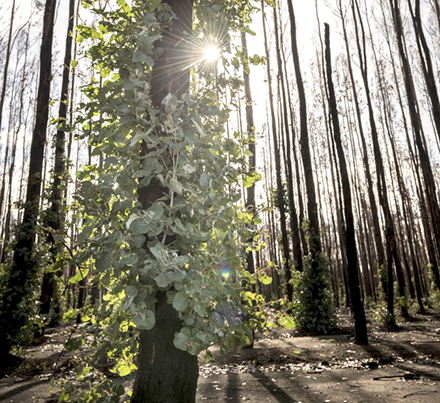Kangaroo Island’s fire-damaged pine trees which are at most risk of decay will be the initial focus of salvage operations on the island to recover the higher value logs. Around 90% of Kangaroo Island Plantation Timbers’ trees valued in excess of $100 million and all of the island’s independent plantations were affected in some way by the by fires in January. Source: Timberbiz
Advice to the company is that the target logs must be harvested within two years and stored under water or sprinklers in order to preserve value.
This strategy is expected to allow the company to maximise recoverable volume, as it awaits approval for the KI Seaport facility at Smith Bay.
Kangaroo Island Plantation Timbers has advised the three levels of government about its plans to start harvesting.
An Expression of Interests (EOI) process started in 2019 for provision of harvest and haul services and the company has received proposals from a number of operators to start initially in the pine and then move to the bluegums.
KIPT is also in discussions with independent growers on the Island regarding harvest of their fire-damaged trees.
Early work will start this calendar year prioritising trees along power lines, in consultation with SA Power Networks. It is expected that the pine harvest will start early next year.
The company expects to salvage three million tonnes of timber with sufficient value to support building of the KI Seaport.
Other uses are being contemplated for a further 1.5 million tonnes of timber not considered suitable for log export.
The salvage harvest is expected to generate in excess of $200 million in economic activity for the Island over the next four years, excluding the beneficial impact of the port.
Managing Director Keith Lamb said that in the December 2019 company accounts the Board took the prudent step to reset the shareholder value of the fire-affected crop to zero.
But he said that this did not mean crop is worthless.
“There is, in our estimation, sufficient residual value to justify the cost of harvest and transport, as well as building the KI Seaport at Smith Bay,” Mr Lamb said.
“This in turn presents significant benefits for the island economy through the creation of new well-paid skilled jobs in forest production.”
The alternative, to chain and burn the 4.5 million tonnes of standing timber, would not benefit anyone and would likely cause significant environmental impact through the release of smoke, ash and carbon dioxide.
The Board has made the decision to move forward with salvage harvesting, taking into account the need for timeliness in order to maximise recoverable volume.
The stockpiling strategy will be managed carefully to take into account company cash reserves and value-at-risk, while the approval process for the KI Seaport is completed.
“We look forward to working with all stakeholders to maximise the benefits of the forestry industry for Kangaroo Island,” Mr Lamb said.






